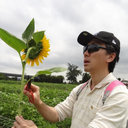Ultrastrong trapping of VEGF by graphene oxide: Anti-angiogenesis application.
Fjalë kyçe
Abstrakt
Angiogenesis is the process of formation of new blood vessels, which is essential to human biology, and also plays a crucial role in several pathologies such as tumor growth and metastasis, exudative age-related macular degeneration, and ischemia. Vascular endothelial growth factor (VEGF), in particular, VEGF-A165 is the most important pro-angiogenic factor for angiogenesis. Thus, blocking the interaction between VEGFs and their receptors is considered an effective anti-angiogenic strategy. We demonstrate for that first time that bovine serum albumin-capped graphene oxide (BSA-GO) exhibits high stability in physiological saline solution and possesses ultrastrong binding affinity towards VEGF-A165 [dissociation constant (Kd) ∼3 × 10-12 M], which is at least five orders of magnitude stronger than that of high-abundant plasma proteins such as human serum albumin, fibrinogen, transferrin, and immunoglobulin G. Due to the surprising binding specificity of BSA-GO for VEGF-A165 in complex plasma fluid, we have also studied the anti-angiogenic effects in vitro and in vivo. Results show that BSA-GO not only effectively inhibits the proliferation, migration and tube formation of human umbilical vein endothelial cells, but also strongly disturbs the physiological process of angiogenesis in chick chorioallantoic membrane and blocks VEGF-A165-induced blood vessel formation in rabbit corneal neovascularization. Our findings indicate that GO nanomaterials can potentially act as therapeutic anti-angiogenic agents via ultrastrong VEGF adsorption and its activity suppression.


